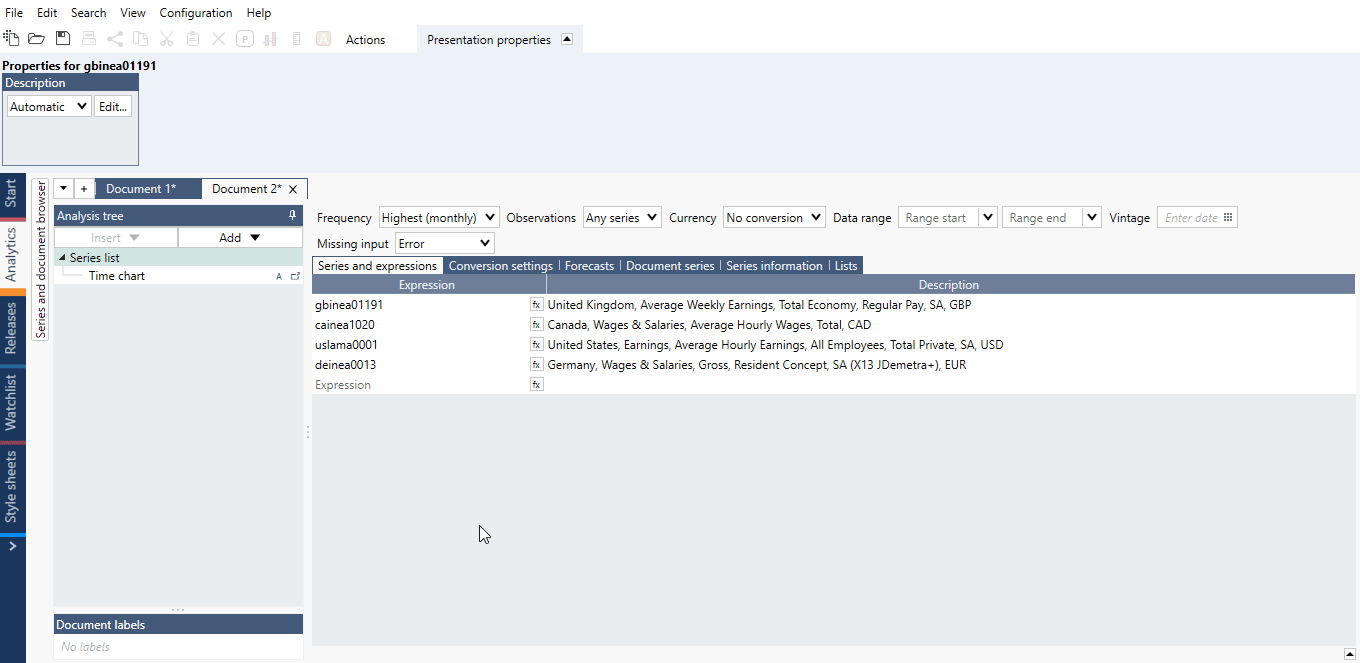Overview
Example of general use of Rate of change analysis calculating YoY% for a group of series:

The Rate of change analysis is used to calculate the change in value or in percentage over periods of time (COP). These changes can also be annualized. The analysis will help you visualize and compare how series are changing over time and is commonly used to calculate differences before applying regressions or correlations
Settings
Method
Change over period value
Calculates the difference in value over the time. This can also be called “momentum”.
Change over period %
Calculates the percentage change over the time.
Annual rate value
Calculates the sum of the values over the time and then scales the result to a yearly level.
where c is the typical number of observations for one year.
Annual rate %
Calculates the percentage change over the time and then annualizes.
where c is the typical number of observations for one year.
Logarithmic change over period %
Calculates the logarithmic percentage change over the time.
Length
Specify the length of the period, or horizon, over which the change will be calculated.
Mode
The mode determines how the period length is measured.
Fixed period
The period length will be a constant number of observations that is determined based on the frequency of the series. Select this option if it is important to use a constant period length and that each value of the past is used only once.
Calendar date
The period length is determined for each observation based on the calendar date so that an observation with a corresponding date in the past is selected. Select this option when it’s important to compare values of corresponding dates even if it means that some values might be used twice and some not at all. A common use case for this mode is when you have converted a series from a lower frequency. The calendar date mode uses the ISDA standard of Actual/Actual day count fraction.
In general, 'Calendar date' more is designed for daily series. You should use it when you want to compare values corresponding to the same date at a previous point in time.
Force
The application recognizes if a series is already expressed as a rate of change and will return an error if you attempt to calculate a rate of change twice. You can bypass this check by selecting the force option.
Examples
In this example, we calculated by how many persons the jobless claims have increased or decreased compared to a year ago. We did this by selecting change over period value for a length of 1 year.
Here, we compared two different growth rates of the German GDP. The line displays year on year growth rates and the columns represent annualized quarterly growth rates.
Questions
- What is the difference between the Rate of change analysis and selecting ‘Rate of change since’ when doing a Cross sampling analysis?
- Why annualization in Rate of change analysis works differently than in Cross sampling analysis?
What is the difference between the Rate of change analysis and selecting ‘Rate of change since’ when doing a Cross sampling analysis?
- Rate of change analysis calculates the changes from the end of each time series while
- 'Rate of change since' in Scalar analysis calculates it from the end of the whole calendar. Meaning that if some series do not end at the same observation date, the calculation range will differ.
You can set the 'Range Start' and 'Range End' in the Scalar analysis to make sure the calculation is done on the same range across all input series.
Example:
Why annualization in Rate of change analysis works differently than in Cross sampling analysis?
Rate of change is by default set to 'Mode: Fixed period'. There is also another mode there - 'Calendar date' - which is helpful when working with a Daily series or for when using Annual rate. Annualization is done differently when you select 'Calendar mode' since Macrobond then use the actual length of the period to do annualization. If you switch it to 'Calendar mode' you will get same value in both analyses.